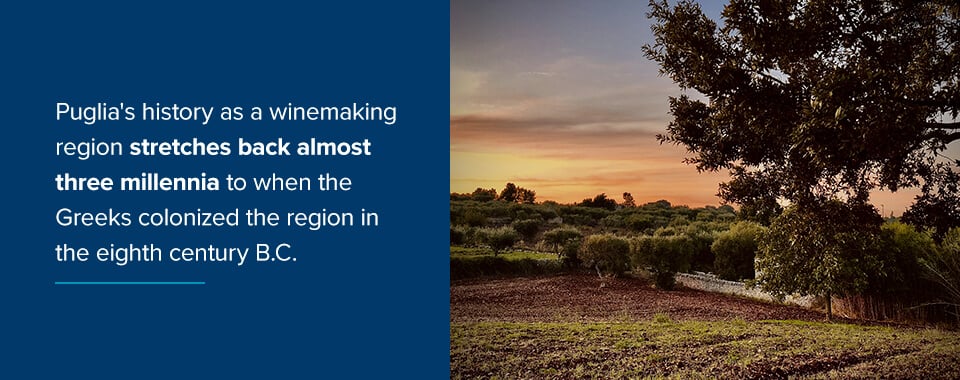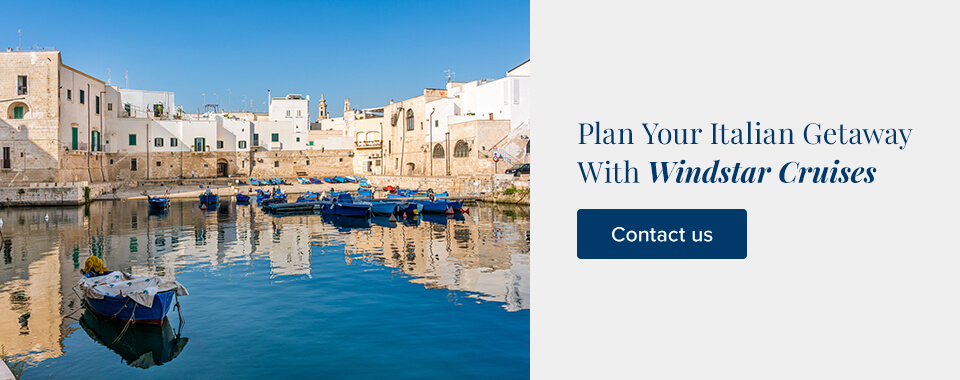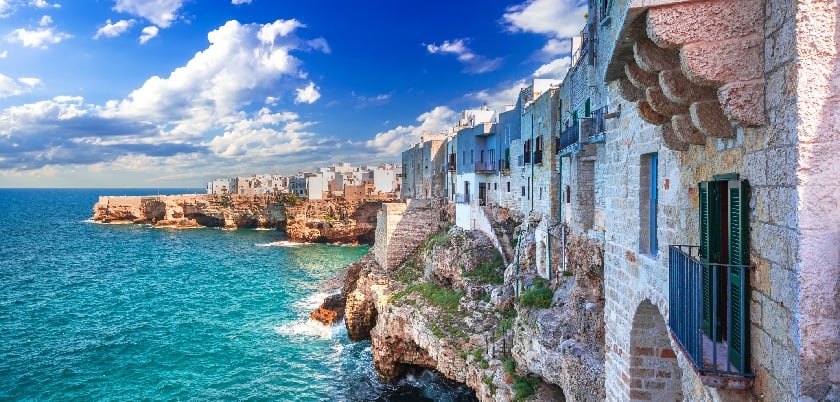
Have you ever tasted Puglian wine? This prominent wine-producing region is a wonderful destination for romantics, history buffs and amateur sommeliers alike.
While Puglian tourism has been on the rise in recent years, much of the region is still off the main tourist track. Here’s why you need to visit.
In This Article
- Where Is Puglia?
- The History of Winemaking in Puglia
- Types of Wine Puglia Produces
- Plan Your Italian Getaway With Windstar Cruises
Where Is Puglia?
Puglia —Apulia in English — is the long, thin region that makes up the southeastern “heel” of the Italian peninsula’s “boot.” It’s home to quaint villages, picturesque farms and breathtaking castles — and, of course, wine.
Puglia’s warm climate and fertile soil make the region perfect for growing wine grapes, which is why it’s tied with Sicily for the second-largest wine-producing region in Italy. It’s also the country’s top olive oil region, contributing nearly 40% of Italy’s total production. It’s also the birthplace of burrata, a soft cheese made from mozzarella and cream.
Puglia is also a region that beautifully blends old and new. Throughout the region, you’ll find idyllic vineyards, old churches and ancient ruins from generations past. And while it used to have a reputation for producing low-end bulk wine, up-and-coming independent wineries are transforming the region with innovative, artisanal blends.
The History of Winemaking in Puglia

Puglia’s history as a winemaking region stretches back almost three millennia to when the Greeks colonized the region in the eighth century B.C. These early occupants brought with them grapevines from across the Adriatic Sea. Some of these varieties still grow in Puglia today, such as Negroamaro and Nero di Troia.
Puglia experienced a viticultural boom after the Romans conquered the region in the third century B.C. The construction of the Via Appia, which connected the Puglian colonies of Taranto and Venosa to Rome, allowed local winemakers to transport their products throughout the empire.
Wine culture continued to flourish in the region until the 1800s, when disaster struck.
19th Century: The Great Phylloxera Outbreak
In the early 1860s, French grapevines began to wither and die for seemingly no reason. The cause?
Phylloxera, a tiny bug that eats the roots of grapevines, had somehow made its way across the sea from North America to the European continent. And it wreaked havoc on European viticulture.
The epidemic lasted until the late 1880s, when researchers discovered they could stop the phylloxera from feeding by grafting roots from resistant North American grapevines onto European plants.
The resurrection of Italian wine post-outbreak began in Salento, a town in southern Puglia. For the first time, Puglian wine was bottled and commercialized locally rather than sold off to other winemaking regions. These wines were some of the first in the country to be sold after the epidemic.
Recovery From World War II
After the destruction of the World Wars, northern Italy received significant investments in reconstruction. The southern part of the country suffered from widespread poverty, and many young people left to seek better opportunities elsewhere.
Things finally began turning around in the mid-1980s, when local entrepreneurs poured money and effort into transforming Puglia’s tourism industry. Today, Puglian winemakers are working to reinvent the region as a top destination for artisanal wines and vibrant culture.
For decades, Puglia was part of “Europe’s cellar” — after selling its best grapes to other Italian winemaking regions, Puglia would be left with whatever was at the bottom of the barrel. As a bulk wine producer, the region developed a reputation for producing lots of low-quality wine.
But modern Puglian winemakers are creating wines that rival those of better-known winemaking regions, like Veneto and Tuscany.
Types of Wine Puglia Produces
Puglian wine is known for its full-bodied, fruit-forward red wines, though there are plenty of white and Rosato (rosé) varieties available as well.
The two most popular Puglian red wines are:
- Primitivo: If you’ve tried Zinfandel, you’ve tried Primitivo grapes! Italian immigrants brought these early-ripening grapes with them to the U.S. in the 19th and 20th centuries. They produce bold and fruity wines with a distinct jammy taste that resembles dried fruit. Try a Primitivo wine with a Puglian dish like parmigiana di melanzane — that’s eggplant Parmesan in English.
- Salice Salentino: Made from Negroamaro grapes in the southern region of Salento, Salice Salentino is a dry red varietal with low acidity and a robust body. Its unique flavor profile offers hints of raspberry, plum and spices, which goes well with olive oil-based Mediterranean foods like antipasti, savory soups and grilled meats.
Curious about the region’s lesser-known offerings? You can find many different types of wine grapes in Puglia, including:
- Bombino Nero: This late-ripening red grape has thin skin, making it perfect for Rosato. Bombino Nero Rosato is high in acidity and has a fruity, floral flavor profile with hints of strawberry and rose petals. It pairs well with charcuterie, pizza, salads and seafood.
- Bombino Bianco: This white wine grape produces light-bodied, soft wines with subtle notes of citrus and wildflowers. You’re most likely to find it in blends or sparkling wines, which pair well with fresh cheeses, pasta and lean fish. It’s also commonly used to make raisins.
- Nero di Troia: This black-skinned grape is native to northern Puglia and most commonly found in dry red wines. It has a medium acidity and high tannins, with rich flavors like licorice, plum and tobacco. Such a bold taste makes it a perfect fit for rich dishes like lasagna and roasted game.
- Verdeca: Verdeca grapes are neutral in flavor and unique to Puglia, though they’ve fallen out of fashion in recent years. Wines that feature Verdeca are usually light-bodied and refreshing, with notes of pineapple and citrus that make them a delightful complement to shellfish and fresh vegetables.
- Greco Bianco: Historians believe this millennia-old white grape has ties to ancient Greece — it may have been one of the original grapes planted by the Greek colonizers during the eighth century. It’s often used in dessert wines, but you might also find it in dry wines. Ideal pairings for Greco Bianco-based wines include pasta with shellfish and candied nuts.
For those who want to experience the Puglian wine scene for themselves, we recommend taking a tour through the vineyards or enjoying a wine pairing session at one of the region’s many wineries.
Plan Your Italian Getaway With Windstar Cruises

Are you dreaming of sipping Puglian wine by the sea? A romantic tour through the region’s sprawling vineyards? When you set sail on one of our ships, you get to choose your own Italian adventure. Our small yachts provide an intimate, personal experience so you can truly enjoy the trip of a lifetime.
Request a brochure or give us a call for more information about booking an Italian cruise.





